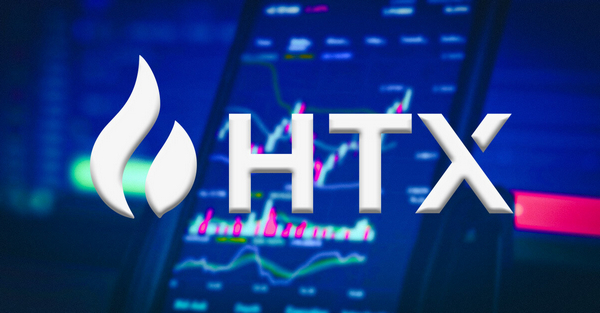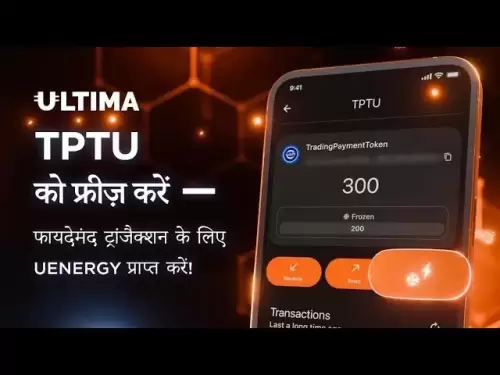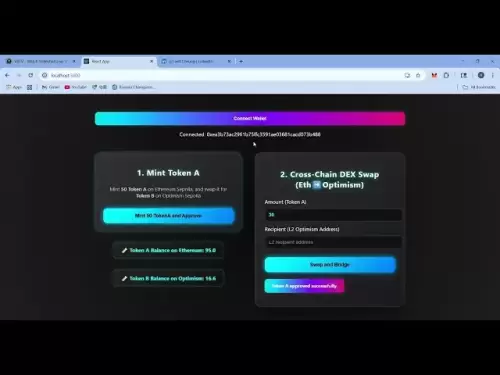-
 Bitcoin
Bitcoin $109,459.7682
2.44% -
 Ethereum
Ethereum $2,598.6052
6.29% -
 Tether USDt
Tether USDt $1.0003
0.00% -
 XRP
XRP $2.2734
3.95% -
 BNB
BNB $661.4886
1.58% -
 Solana
Solana $155.4825
4.35% -
 USDC
USDC $0.9999
-0.02% -
 TRON
TRON $0.2838
1.04% -
 Dogecoin
Dogecoin $0.1740
8.25% -
 Cardano
Cardano $0.6047
9.04% -
 Hyperliquid
Hyperliquid $40.2302
6.50% -
 Sui
Sui $2.9863
10.05% -
 Bitcoin Cash
Bitcoin Cash $509.5786
0.60% -
 Chainlink
Chainlink $13.8156
6.03% -
 UNUS SED LEO
UNUS SED LEO $9.0142
0.69% -
 Avalanche
Avalanche $19.0337
8.68% -
 Stellar
Stellar $0.2438
5.17% -
 Toncoin
Toncoin $2.9012
3.59% -
 Shiba Inu
Shiba Inu $0.0...01210
6.20% -
 Litecoin
Litecoin $90.0882
7.05% -
 Hedera
Hedera $0.1597
8.53% -
 Monero
Monero $326.3340
2.88% -
 Polkadot
Polkadot $3.6365
9.32% -
 Bitget Token
Bitget Token $4.6162
2.72% -
 Dai
Dai $1.0001
0.00% -
 Ethena USDe
Ethena USDe $1.0002
-0.01% -
 Uniswap
Uniswap $7.6403
10.47% -
 Pepe
Pepe $0.0...01060
12.03% -
 Aave
Aave $281.3664
7.56% -
 Pi
Pi $0.4992
1.76%
H How to trade contracts on Huobi
Contract trading on Huobi offers numerous advantages, including hedging against price fluctuations, speculating on underlying crypto assets without ownership, and utilizing diverse contract types such as perpetual swaps and futures.
Nov 12, 2024 at 04:28 am

How to Trade Contracts on Huobi: A Comprehensive Guide for Beginners
Huobi, one of the world's largest cryptocurrency exchanges, offers a robust platform for contract trading, allowing users to speculate on the price movements of underlying cryptocurrencies without actually owning them. Contract trading involves buying or selling contracts that represent the right to buy or sell an underlying asset at a predetermined price and time. This guide will provide you with a step-by-step approach to contract trading on Huobi, helping you navigate the platform and execute successful trades.
Step 1: Understanding Contract Basics
- What is a Contract? A contract, in the context of cryptocurrency trading, is an agreement between two parties to trade an asset at a specific price and time in the future. The contract specifies the underlying asset, the contract size, the price at which the buyer can buy or seller can sell, and the expiration date.
- Margin Trading vs. Contract Trading: Margin trading involves borrowing funds from the exchange to increase your buying or selling power, while contract trading involves the purchase or sale of contracts representing an underlying asset, eliminating the need for leverage.
- Hedging with Contracts: Contracts can be used for hedging against price fluctuations of underlying assets. By taking opposite positions in the futures market, traders can offset potential losses in the spot market.
Step 2: Choosing the Right Contract
- Different Contract Types: Huobi offers three types of contracts: perpetual swaps, futures contracts, and options contracts. Perpetual swaps have no fixed expiration date, futures contracts expire at a specific date in the future, and options contracts grant the buyer the right, but not the obligation, to buy or sell an underlying asset at a specified price.
- Underlying Assets: Huobi allows contract trading for various underlying cryptocurrencies, including Bitcoin, Ethereum, Litecoin, and many others.
- Contract Size: The contract size represents the number of underlying assets represented by each contract. This can vary depending on the underlying asset and the type of contract.
- Expiration Date: Futures contracts have a fixed expiration date, which traders should be aware of when making trading decisions.
Step 3: Opening a Trade
- Create an Order: To open a position, traders need to create an order specifying the type of contract, the underlying asset, the contract size, the price, and the type of order (e.g., market order, limit order).
- Margin Requirements: Contract trading requires traders to maintain a minimum balance called margin. The margin acts as collateral for the potential losses, and its amount varies depending on the underlying asset and the contract type.
- Execution: Once an order is created, it is added to the order book and executed when a matching order meets the specified conditions (e.g., price and quantity).
Step 4: Managing your Trade
- Tracking Market Movements: Traders should closely monitor the price movements of the underlying assets to make informed decisions about their positions.
- Adjusting Margins: Fluctuations in the underlying asset's price may require traders to adjust their margins to avoid potential liquidations.
- Using Stop Loss Orders: Stop loss orders can be used to automatically exit positions when the price reaches a pre-determined level, limiting potential losses.
Step 5: Closing your Trade
- Flatting Positions: Traders can cancel their open positions by creating opposite orders for the same size and contract.
- Taking Profits: Once the desired profit level is reached, traders can close their positions to realize their gains.
- Letting Contracts Expire: In the case of futures contracts, traders can hold their positions until the contract expires.
Disclaimer:info@kdj.com
The information provided is not trading advice. kdj.com does not assume any responsibility for any investments made based on the information provided in this article. Cryptocurrencies are highly volatile and it is highly recommended that you invest with caution after thorough research!
If you believe that the content used on this website infringes your copyright, please contact us immediately (info@kdj.com) and we will delete it promptly.
- Eurau Stablecoin: Deutsche Bank, Galaxy, and Bafin Approval Usher in New Era
- 2025-07-03 20:30:12
- Solana DEX Volume and Ranking: Riding the Wave to the Top
- 2025-07-03 21:10:20
- BONK ETF Buzz: News, Catalysts, and What's Driving the Meme Coin Mania
- 2025-07-03 21:10:20
- Check Your Change! That 1p Coin Could Be Worth £200k!
- 2025-07-03 21:20:17
- Mosman Oil's Vecta Termination: A Drilling Programme Debrief
- 2025-07-03 20:30:12
- HYPE Price Forecast: Will It Reach $50 by July 2025?
- 2025-07-03 21:20:18
Related knowledge

How to identify the contract value range in combination with the market profile?
Jul 02,2025 at 10:56pm
Understanding the Market ProfileTo effectively identify the contract value range in combination with the market profile, it's essential to first understand what each concept entails. The market profile is a framework that helps traders visualize how price and time interact across a given period, typically a trading day or session. It provides insights i...

How to use the price slope to filter the false breakthrough signal of the contract?
Jun 20,2025 at 06:56pm
Understanding the Concept of Price Slope in Contract TradingIn contract trading, especially within cryptocurrency derivatives markets, price slope refers to the rate at which the price changes over a specific time period. It helps traders assess the strength and sustainability of a trend. A steep slope may indicate strong momentum, while a shallow slope...

How to determine the expected volatility of the contract through the volatility cone?
Jun 19,2025 at 12:28pm
Understanding the Basics of Volatility in Cryptocurrency ContractsIn the realm of cryptocurrency trading, volatility is a key metric that traders use to assess potential risk and reward. When dealing with futures contracts, understanding how volatile an asset might become over time is crucial for position sizing, risk management, and strategy developmen...

How to formulate a contract intraday trading plan in combination with the pivot point system?
Jun 21,2025 at 03:42pm
Understanding the Basics of Pivot Points in Cryptocurrency TradingPivot points are technical analysis tools used by traders to identify potential support and resistance levels. These levels are calculated using the previous day's high, low, and closing prices. In the context of cryptocurrency trading, where markets operate 24/7, pivot points help trader...

How to adjust the contract position ratio through the price fluctuation entropy?
Jun 22,2025 at 11:42am
Understanding Price Fluctuation Entropy in Cryptocurrency ContractsIn the world of cryptocurrency futures trading, price fluctuation entropy is a relatively new concept used to measure market volatility and uncertainty. It derives from information theory, where entropy refers to the degree of randomness or unpredictability in a system. In crypto contrac...

How to use the volume swing indicator to predict the contract volume-price divergence?
Jun 18,2025 at 11:42pm
Understanding the Volume Swing IndicatorThe volume swing indicator is a technical analysis tool used primarily in cryptocurrency trading to evaluate changes in volume over time. Unlike price-based indicators, this metric focuses solely on trading volume, which can provide early signals about potential market reversals or continuations. The key idea behi...

How to identify the contract value range in combination with the market profile?
Jul 02,2025 at 10:56pm
Understanding the Market ProfileTo effectively identify the contract value range in combination with the market profile, it's essential to first understand what each concept entails. The market profile is a framework that helps traders visualize how price and time interact across a given period, typically a trading day or session. It provides insights i...

How to use the price slope to filter the false breakthrough signal of the contract?
Jun 20,2025 at 06:56pm
Understanding the Concept of Price Slope in Contract TradingIn contract trading, especially within cryptocurrency derivatives markets, price slope refers to the rate at which the price changes over a specific time period. It helps traders assess the strength and sustainability of a trend. A steep slope may indicate strong momentum, while a shallow slope...

How to determine the expected volatility of the contract through the volatility cone?
Jun 19,2025 at 12:28pm
Understanding the Basics of Volatility in Cryptocurrency ContractsIn the realm of cryptocurrency trading, volatility is a key metric that traders use to assess potential risk and reward. When dealing with futures contracts, understanding how volatile an asset might become over time is crucial for position sizing, risk management, and strategy developmen...

How to formulate a contract intraday trading plan in combination with the pivot point system?
Jun 21,2025 at 03:42pm
Understanding the Basics of Pivot Points in Cryptocurrency TradingPivot points are technical analysis tools used by traders to identify potential support and resistance levels. These levels are calculated using the previous day's high, low, and closing prices. In the context of cryptocurrency trading, where markets operate 24/7, pivot points help trader...

How to adjust the contract position ratio through the price fluctuation entropy?
Jun 22,2025 at 11:42am
Understanding Price Fluctuation Entropy in Cryptocurrency ContractsIn the world of cryptocurrency futures trading, price fluctuation entropy is a relatively new concept used to measure market volatility and uncertainty. It derives from information theory, where entropy refers to the degree of randomness or unpredictability in a system. In crypto contrac...

How to use the volume swing indicator to predict the contract volume-price divergence?
Jun 18,2025 at 11:42pm
Understanding the Volume Swing IndicatorThe volume swing indicator is a technical analysis tool used primarily in cryptocurrency trading to evaluate changes in volume over time. Unlike price-based indicators, this metric focuses solely on trading volume, which can provide early signals about potential market reversals or continuations. The key idea behi...
See all articles

























































































